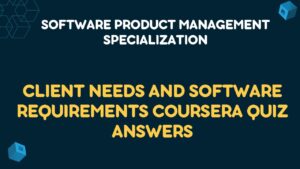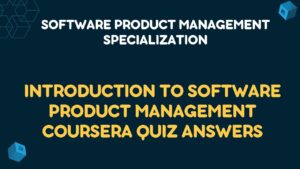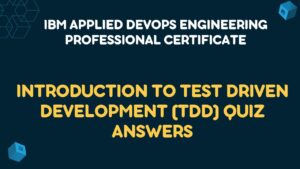Table of Contents
Developing Cloud Native Applications Week 01 Quiz Answers
Quiz : Module 1 Graded Quiz
Q1. Which of the following is not part of the cloud native stack?
- Application code
- Application runtime
- Machine learning models
- Cloud infrastructure
Q2. Cloud native applications consist of microservices working together to comprise an application. Where are the microservices typically packaged?
- Libraries
- Vaults
- Containers
- Sandbox
Q3. What is one of the efforts that CNCF considers their responsibility?
- Reviewing project submissions
- Developing new technology
- Making technologies accessible and reliable
- Making cloud native computing ubiquitous
Q4. CNCF technology projects progress through three ascending stages. Which is the middle stage?
- Submission
- Incubated
- Graduate
- Sandbox
Q5. The app modernization effort touches which stages of application development?
- Innovation, Agile Delivery, Cost Reduction
- Cloud Native, Cloud Ready, Traditional
- Build, Deploy, and Run
- Refactor, Repackage, Test
Q6. Which of these modernization patterns involve leaving the complex parts of the application as is?
- Expose APIs
- Migrate monolith to a cloud runtime
- Refactor to microservices
- Strangle the monolith
Q7. What pattern does TDD follow?
- Only some of the code is backed by a test
- Green-red-deploy
- Write code and then test
- Red-green-refactor
Q8. What does an SRE use to reveal system downtime when making changes?
- Controlled risk
- Error budgets
- Service-level agreements
- Service-level objectives
Q9. What is an important reason why organizations use public and hosted private clouds?
- Lack of concern with platform and infrastructure needs
- Remove developer concerns and commitment about storage and memory
- Cut costs by reducing IT staff
- Increase security
Q10. What is the difference between a private hosted cloud and a private cloud?
- A private cloud can be hosted and maintained by an organization on premises
- A private cloud can be hosted by an external vendor but maintained by the organization
- Hosted private clouds are maintained by an external vendor for one organization
- All of the above
Developing Cloud Native Applications Week 02 Quiz Answers
Quiz : Module 2 Graded Quiz
Q1. What is one of the IBM Cloud catalog categories for infrastructure resources?
- IoT
- Networking
- Application
- Service
Q2. What resources do virtual servers share with other operating systems?
- Functions
- Software resources
- Web applications
- Cloud Foundry Apps
Q3. How are runtime environments integrated into IBM Cloud?
- As buildpacks
- As templates
- As services
- As applications
Q4. What is one of the resources found in the IBM Cloud Default Dashboard?
- Available memory
- Storage size
- Application logs
- Network bandwidth
Q5. When you bind a service to an application, where are the credentials stored?
- Application environment variables
- Service dashboard
- Service variables
- User-defined environment variable
Q6. What responsibility does the resource controller have?
- Manages access to Cloud Foundry regions
- Manages IAM
- Determines account resources
- Manages the lifecycle of account resources
Q7. What is one of the advantages that services using Cloud IAM have over services based on Cloud Foundry?
- Coarse-grained access control
- Collaboration among team members
- Connect to apps in different organizations
- None
Q8. What Cloud Foundry user role can enable features for spaces?
- Space auditors
- Space developers
- Organization auditors
- Space managers
Q9. What holds the credentials of the service that you bind to an application?
- SystemRoot
- Temp
- AppData
- VCAP_SERVICES
Q10. What roles do the basic concept “rules” perform for IBM Cloud functions?
- Triggering actions
- Linking triggers to actions or sequences
- Piece of code performing one specific task
- Flow of actions to complete one function
Developing Cloud Native Applications Week 03 Quiz Answers
Quiz : Module 3 Graded Quiz
Q1. Node.js is the server-side component that runs what language?
- Java
- Python
- Ruby
- JavaScript
Q2. What advantage does Node.js provide by being event-driven and using asynchronous, non-blocking I/O?
- Less code
- Lower cost
- Easier maintenance
- Easy to scale
Q3. What open source engine does Node.js run on?
- V8
- V6
- Apache Lucene Core
- Panda 3D
Q4. What is one of the things you can manage with IBM Cloud CLI?
- Credit card payment
- Infrastructure
- Network
- IDEs
Q5. In ibmcloud CLIs, what can you use to automate the management and deployment process?
- Markdown
- Shell scripts
- HTML
- XML
Q6. After installing IBM Cloud CLI, what command can you use to verify the tool works in your environment?
- ibmcloud –check
- ibmcloud –version
- ibmcloud status
- ibmcloud cli
Q7. When you use a federated ID to log in to your IBM Cloud, what command do you use?
- login
- ibmcloud login –fid
- cf login
- ibmcloud login –sso
Q8. What syntax is recommended for use in IBM Cloud CLI for cf commands?
- cf <command>
- ibmcloud <cf_command>
- ibmcloud cf <cf_command>
- cf ibmcloud <command>
Q9. What command lets you upload, deploy, and start a Cloud Foundry application in IBM Cloud?
- ibmcloud push
- cf target
- ibmcloud pull
- ibmcloud app push
Q10. What file stores the deployment settings for a cf application in IBM Cloud?
- Manifest.xml
- Manifest.yml
- Manifest.SXML
- Manifest.txt
Developing Cloud Native Applications Week 04 Quiz Answers
Quiz : Module 4 Graded Quiz
Q1. With DevOps, which teams work together to support the software lifecycle from code design to deployment to production?
- Development and operations
- Development and security
- Deployment and operations
- Deployment and testing
Q2. Where is DevOps code continuously delivered and integrated into?
- The desktop application
- The IBM Cloud catalog
- The main shared repository
- The market feedback tool
Q3. Which Continuous Delivery feature can you use to automate builds, unit tests, and deployment?
- Issue tracker
- Git repository
- Delivery Pipeline
- Web IDE
Q4. Fill in the blank: Using the Continuous Delivery service, you can create DevOps toolchains to enable tool _____ that support your development, deployment, and operations tasks.
- Integrations
- Collaborations
- Segmentations
- Environments
Q5. Fill in the blank: The following are all ways to add a toolchain to your Continuous Delivery instance EXCEPT _____.
- Click Create a Toolchain on the Getting Started page that appears when you create the service
- Clone the main repository
- Enable Continuous Delivery in an existing application
- Add a toolchain from the catalog
Q6. The Continuous Delivery user interface used to create a toolchain groups the tools into which of the following four phases?
- Code, Delivery, Run, Manage
- Think, Code, Deliver, Run
- Think, Code, Deliver, Manage
- Think, Culture, Deliver, Run
Q7. What IBM Cloud feature lets you debug code in the browser ?
- ibmcloud CLI
- IDE
- IBM Cloud Live Sync
- ibm toolchain
Q8. Which Continuous Delivery feature provides a full-featured environment for writing your application code in your web browser?
- Markup language
- Open toolchain
- The Web IDE editor
- Delivery Pipeline
Q9. What does enabling Continuous Delivery for an application create?
- A Git repository to manage source code
- Kubernetes containers
- A pipeline job to run automated tests of code
- IBM Cloud API Docs
Q10. What are you allowed to configure for each stage in Delivery Pipeline ?
- CPU
- Instances
- Environment variables
- Memory
Developing Cloud Native Applications Week 05 Quiz Answers
Quiz : Module 5 Graded Quiz
Q1. What is Representational State Transfer (REST)?
- A web resource
- An architectural style
- An API
- A server-side application
Q2. Fill in the blank: REST uses a Uniform Resource Identifier (URI) to _____.
- Use lightweight data models
- Post data to the server
- Describe the network location of the resource to retrieve or update
- Define the structure of a web page
Q3. What do you use to call a REST service?
- HTML resources
- Server entry points
- HTTP method nouns
- HTTP method verbs
Q4. Which of the following are characteristics of REST and REST services?
- REST provides a simple approach for building services for client/server interactions
- REST services follow standard protocols
- REST services tend to use lightweight data models
- All of the above
Q5. What does a REST service do when you apply it to a server-side application?
- Describes its location on the network server application resource
- Codes the server side in a language like Java or Python
- Defines the structure of a web page
- Makes available an application as a web resource
Q6. Which of the following elements could the REST service write in a response?
- Content-length
- Response body
- Date
- All of the above
Q7. On which two structures is JSON built?
- Array-value pairs and key lists
- Name-value pairs and list of values
- List of values and markup language
- Name-value pairs and HTTP
Q8. Which of these is NOT a characteristic of JSON?
- Easy for applications to parse and generate
- Nesting of objects
- Lightweight data interchange format
- Markup language
Q9. What do Watson services allow you to build?
- Cognitive apps
- IBM Cloud API Docs
- IDE
- Unstructured data
Q10. What do you need to do to use Postman to interact with the Watson Natural Language Understanding (NLU) service?
- Get an IAM token from the user’s NLU service API
- Have the NLU service already created on your IBM account
- Send the URL of the data in the body of the request
- All of the above
Get all IBM Full Stack Cloud Developer Professional Certificate Quiz Answers
Introduction to Cloud Computing Coursera Quiz Answers
Introduction to Web Development with HTML, CSS, JavaScript Quiz Answers
Developing Cloud Native Applications Coursera Quiz Answers
Developing Cloud Apps with Node.js and React Coursera Quiz Answers
Introduction to Containers w/ Docker, Kubernetes & OpenShift Quiz Answers
Python for Data Science, AI & Development Coursera Quiz Answers
Python Project for AI & Application Development Coursera Quiz Answers
Developing Applications with SQL, Databases, and Django Quiz Answers
Application Development using Microservices and Serverless Quiz Answers
Full Stack Cloud Development Capstone Project Coursera Quiz Answers




